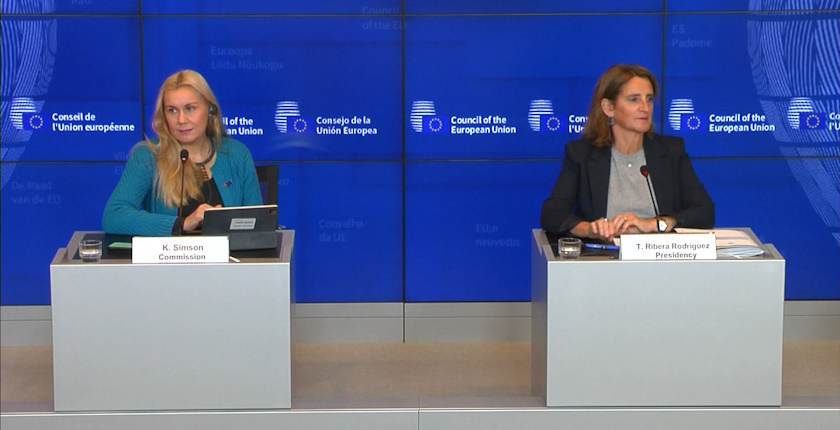
Photo: Council of the EU
The Council of the European Union adopted its so-called general approach to the electricity market design reform, finally enabling the start of negotiations with the European Parliament. Energy ministers found a compromise by allowing a subsidy scheme for nuclear power.
The EU achieved a breakthrough in lengthy negotiations about the electricity market design reform. The initiative was launched when the consequences of Russia’s invasion of Ukraine exacerbated the energy crisis. Fossil gas prices spiked last year and spilled over to the electricity market, hurting households and the economy overall.
The main sticking point, between the pro-nuclear bloc and a group of member states led by Germany, is now said to be resolved. Nuclear power plants would be entitled to subsidies through contracts for difference or CfDs. It marked a win for France and its allies though such mechanisms would only be for “substantially repowering” existing power plants and for future energy investments, Politico learned from insiders.
Germany shut down its last nuclear power plants earlier this year and long pushed against subsidies for the sector. The compromise with the government in Berlin was found through stricter rules in the segment. Energy ministers in the Council of the EU agreed that distortions of competition would be strictly monitored and prevented.
Reform to boost PPA market
The deal enables formal talks with the European Parliament, which adopted its stance in July on the matter.
“The council found an agreement to move ahead with the electricity market proposal. It will help increase the resilience of the European electricity market to any future price shocks coming from tensions on gas markets but also to prepare for a decarbonised future. The reform will bring certainty and predictability for the electricity sector to trigger necessary investments in clean energy infrastructure,” European Commissioner for Energy Kadri Simson said.
Ribera: We will also accelerate the deployment of renewables, a cheaper and cleaner source of energy for our citizens
The reform aims to steady long-term electricity markets by boosting the market for power purchase agreements (PPAs) and other long-term arrangements, generalizing two-way CfDs and improving the liquidity of the forward market, the council said.
“Consumers across the EU will be able to benefit from much more stable prices of energy, less dependency on the price of fossil fuels and better protection from future crises. We will also accelerate the deployment of renewables, a cheaper and cleaner source of energy for our citizens,” said Spain’s Acting Third Deputy Prime Minister and Minister for Ecological Transition and the Demographic Challenge Teresa Ribera Rodríguez. Her country holds the presidency of the Council of the EU until New Year.
Electricity design market reform includes delays for CfD rules
Two-way CfDs are long-term contracts concluded by public entities to support investments. They top up the market price when it is low and ask the generator to pay back an amount when the market price is higher than a certain limit, in order to prevent excessive windfall profits. The format would apply to investments in new power plants based on wind, solar, geothermal and nuclear energy and hydropower without reservoir, the Council of the EU said.
The rules for two-way CfDs would only apply after a transition period of three years (five years for offshore hybrid asset projects connected to two or more bidding zones) after the entry into force of the regulation, in order to maintain legal certainty for ongoing projects.
Opening market for non-fossil flexibility
The deal opens a greater space for green, non-fossil flexibility technologies needed for a market where variable renewables will be predominant, in Simson’s view. It facilitates investment in grid expansion by changing the tariffication methodology, she explained.
Simson pointed to the goal of the package to enhance consumer protection and expand options for energy communities. She described the nuclear power subsidy mechanism as direct price support to lifetime extension investments and said the European Commission would ensure that such instruments are properly designed,
EU-wide electricity supply solutions for vulnerable households
The council introduced clarifications to the provisions on customer protection. It agreed to strengthen it by establishing a free choice of a supplier and the possibility of accessing dynamic electricity prices, fixed-term, and fixed-price contracts.
Energy-poor and vulnerable citizens are set to be protected by suppliers of last resort
The council agreed to stricter rules than previously for suppliers in their price-hedging strategies to shield customers from variations on wholesale markets. It agreed to protect vulnerable customers from disconnections by putting in place supplier-of-last-resort systems.
It was also agreed that all customers would have the right to energy sharing schemes (using, sharing and storing self-generated energy) and that all consumer rights would be extended to final customers involved in energy-sharing schemes.
Under the current rules, member states can apply regulated prices for energy-poor and vulnerable households, and as a transitional measure for households and micro-enterprises whether or not there is an electricity price crisis. The reform adds a temporary option to apply regulated prices, even below cost, to small and medium-sized enterprises (SMEs) in times of crisis.


















Be the first one to comment on this article.